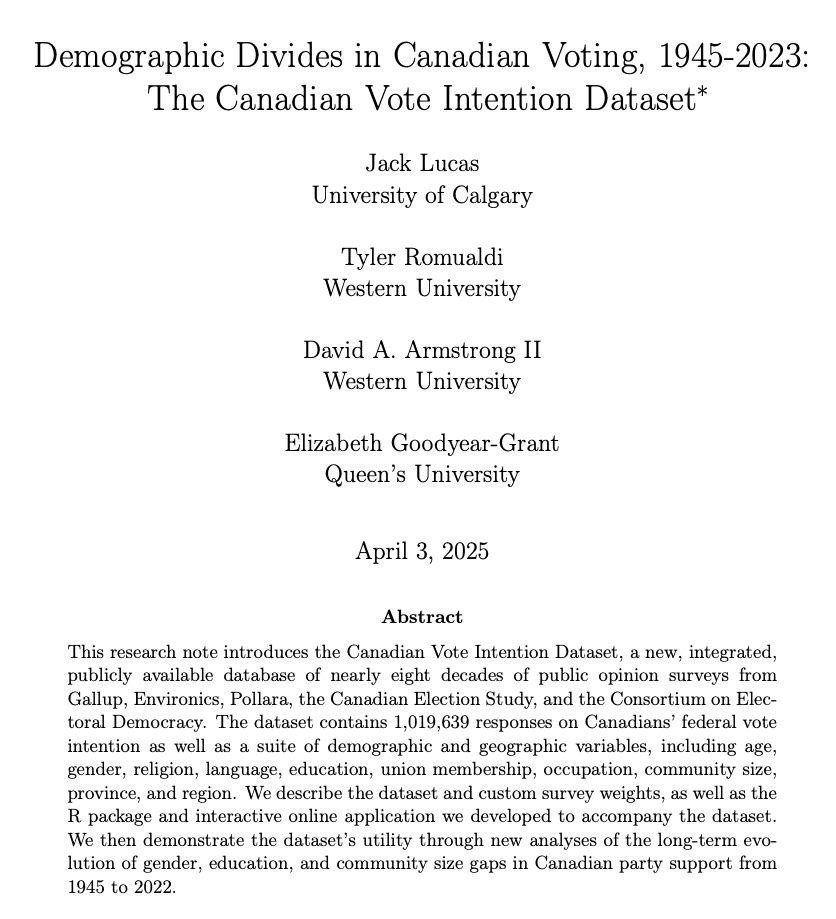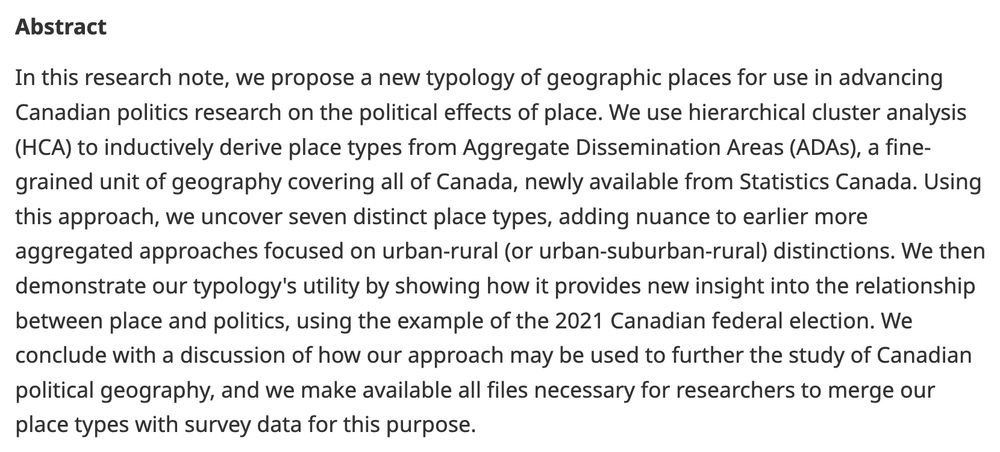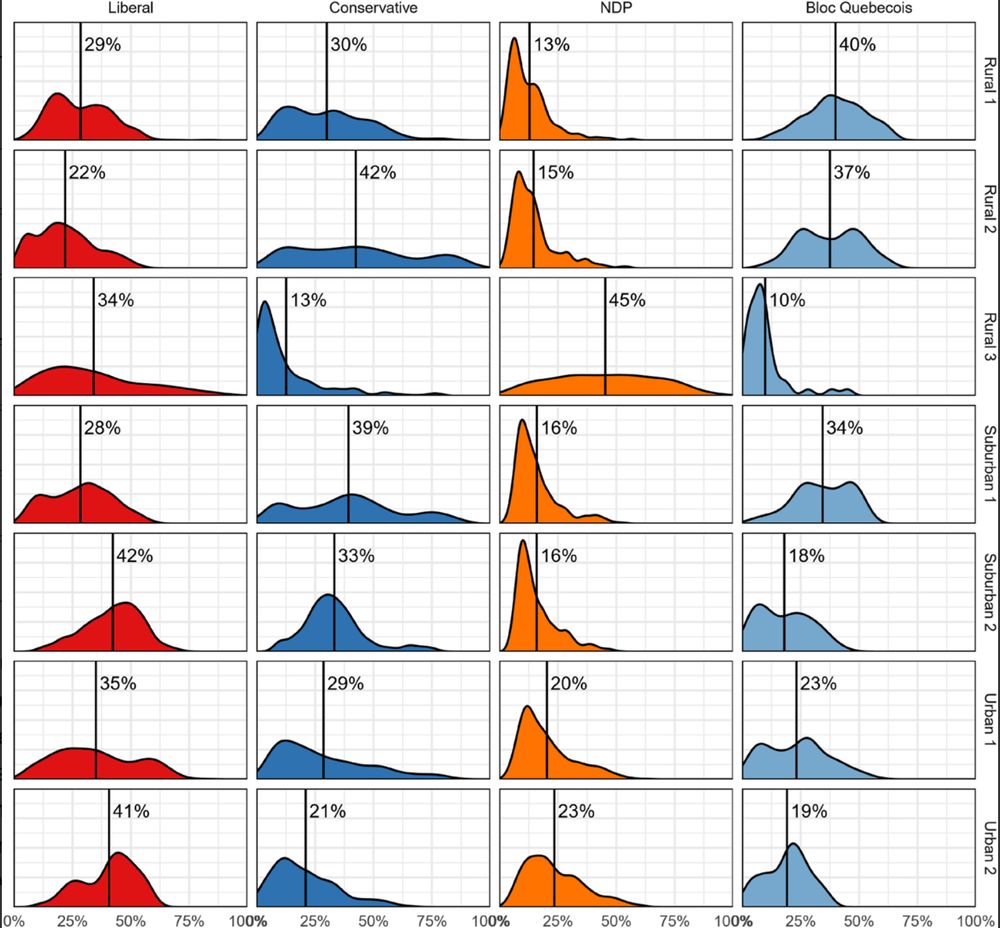Happy to report that this article is now available: doi.org/10.1017/S000.... See Tyler's thread below for more detail on the associated R package and interactive online app.
09.06.2025 16:15 — 👍 3 🔁 2 💬 0 📌 0
Very excited to share our paper on the vote intention dataset in @cjps-rcsp.bsky.social.
See the earlier thread for more on the Shiny app, R package, and descriptive analyses of demographic divides in vote intention. We'll keep updating this resource—stay tuned!
📄 www.cambridge.org/core/journal...
09.06.2025 13:28 — 👍 2 🔁 2 💬 0 📌 0
Special thanks to @anne-imz.bsky.social, the grad students/faculty involved with the CSDC at McGill University, the @clessn.bsky.social research team at Université Laval, and our discussants at past conferences.
We are very grateful for the constructive feedback and thought-provoking questions! 🙂
22.04.2025 13:36 — 👍 1 🔁 0 💬 0 📌 0
As AI’s capabilities expand, opportunities to study the dynamic nature of citizens' risk perceptions and their effects on human behaviour appear boundless.
We hope our dread-controllability framework motivates deeper theoretical and empirical exploration of how citizens perceive AI and its risks.
22.04.2025 13:35 — 👍 0 🔁 0 💬 1 📌 0


We validate these measures by regressing each scale on covariates linked to AI attitudes.
As shown below, key cross-national predictors of AI dread and controllability concerns include trust in scientists, conspiracy thinking, and beliefs that technological change will harm one’s job prospects.
22.04.2025 13:35 — 👍 0 🔁 0 💬 1 📌 0

The items for the AI Dread and AI Controllability Concern Measures.
22.04.2025 13:34 — 👍 0 🔁 0 💬 1 📌 0
Using data from 🇨🇦 and 🇯🇵, we develop four-item dread and controllability measures and identify the single best item to use for researchers with limited survey space.
The scales are highly reliable and largely uncorrelated (r = 0.05 in Canada, 0.01 in Japan). We summarize these new measures below.
22.04.2025 13:33 — 👍 0 🔁 0 💬 1 📌 0
We suggest that controllability concerns stem from:
(a) unease about AI appearing outright out-of-control akin to Frankenstein's monster type scenarios;
(b) uncertainty over who controls it, seen in debates about AI capitalism and authoritarian regimes using AI to push revisionist narratives.
22.04.2025 13:33 — 👍 0 🔁 0 💬 1 📌 0

Image source: https://theweek.com/political-satire/1022837/ai-takeover
If you're like me, some ideas are better contextualized through memes or playful references, like this creative cartoon that loosely illustrates a key component of our dread argument.
Image credit: Joe Heller.
22.04.2025 13:32 — 👍 0 🔁 0 💬 1 📌 0
We theorize that citizens’ dread of AI stems from:
a) Its impact on employability, inequality, and the disappearance of professions.
b) Its capacity to match or surpass human intellect/ undermine human initiative and independent thinking.
c) Its potential to pose existential threats to humanity.
22.04.2025 13:31 — 👍 0 🔁 0 💬 1 📌 0
Dread captures the perceived magnitude of risk associated with AI, while controllability reflects the perceived ability to manage its development and consequences.
We propose a new framework centered on these dimensions and introduce two measures: the AI Dread and AI Controllability Concern Scale.
22.04.2025 13:31 — 👍 0 🔁 0 💬 1 📌 0
Studies often link AI attitudes to demographics, predispositions, or framing. Yet, the factors structuring these beliefs remain contested.
We argue that a growing literature implicitly highlights how citizens’ views of AI and its risks stem from a sense of dread and a perceived lack of control.
22.04.2025 13:31 — 👍 0 🔁 0 💬 1 📌 0

Image and news article source: https://www.aljazeera.com/economy/2024/2/12/how-ai-is-used-to-resurrect-dead-indian-politicians-as-elections-loom

Image and news article source: https://www.theguardian.com/us-news/2024/feb/26/steve-kramer-admits-he-commissioned-robocall-ai-biden-new-hampshire

Image and news article source: https://www.nytimes.com/2022/09/02/technology/ai-artificial-intelligence-artists.html
AI has immense potential to drive innovation, but recent news highlights its complex societal role—from attempts to “resurrect” politicians to sway elections, to using AI to suppress voter turnout or win art competitions. These issues raise a key question: how do lay citizens view AI and its risks?
22.04.2025 13:30 — 👍 0 🔁 0 💬 1 📌 0

How do ordinary citizens think about AI and its associated risks cross-nationally—and how can we measure it?
I’m thrilled to share a new paper in Journal of Risk Research with @tylergirard.bsky.social, Mathieu Turgeon, Yannick Dufresne, Takeshi Iida & Tetsuya Matsubayashi.
doi.org/10.1080/1366...
22.04.2025 13:29 — 👍 4 🔁 1 💬 1 📌 0
This new R package makes it easy to extract weighted annual estimates of vote intention for the major parties going back to the 1940s. For instance, here's annual vote intention for the Liberals, with a red line marking where they currently stand in the polls according to the 338 aggregator.
03.04.2025 17:01 — 👍 3 🔁 1 💬 1 📌 0
If you have any questions or would like to discuss this further, please feel free to reach out to me or Jack.
Let's dive into the data! #CdnPoli #Election2025
03.04.2025 15:37 — 👍 0 🔁 0 💬 0 📌 0
After many years of weekly Zoom hackathon sessions, we're excited to release this!
We'll continue updating the resource (soon with issue attitudes) and hope it helps illuminate key demographic trends, regional shifts, and electoral changes from postwar realignments to contemporary divides.
03.04.2025 15:37 — 👍 1 🔁 0 💬 1 📌 0
Canadian Voting and Attitudes Project - Voting Analysis
Special thanks to Dave Armstrong for leading the way with the R package and Shiny App! The Shiny is available here: quantoid.shinyapps.io/cvpa_app/
03.04.2025 15:35 — 👍 0 🔁 0 💬 1 📌 0


We also hope the data will be a helpful tool for teaching and reaching the wider public. It allows users to select a specific demographic variable, choose parties, and view trends in vote intent/choice or explore the cross-classification of two variables, such as gender and education (among others)
03.04.2025 15:35 — 👍 3 🔁 0 💬 1 📌 0
The first function, wtd_vote, creates weighted estimates of party support for specified demographic groups, while gap_analysis generates statistical estimates of the difference in support among demographic group members for each party. Each figure above was created using these functions.
03.04.2025 15:32 — 👍 0 🔁 0 💬 1 📌 0
In addition, we’ve created a new R package, Canadian Voting and Policy Attitudes ("CVPA"). The CVPA package focuses on providing weighted party support by demographic groups over time. It contains the raw data and two functions designed to be particularly helpful for researchers.
03.04.2025 15:32 — 👍 1 🔁 0 💬 1 📌 1
Canadian Vote Intention Dataset
The Canadian Vote Intention Dataset is a new and harmonized database spanning nearly eight decades (1945–2023) of public opinion surveys from Gallu...
Special thanks to Alex Cooper at Queen's University for making the dataset publicly available on the Canadian Opinion Research Archive! Those interested can download the data here: doi.org/10.5683/SP3/...
03.04.2025 15:31 — 👍 0 🔁 0 💬 1 📌 0

The dataset also includes age, education, gender, occupation, religion, union membership, language (not pictured), province, region, and community size variables. It also provides weights, survey mode, and interview dates, offering new insights into responsiveness to events and survey methodology.
03.04.2025 15:30 — 👍 0 🔁 0 💬 1 📌 0

And the community size divide...
03.04.2025 15:29 — 👍 0 🔁 0 💬 1 📌 0


We believe the dataset is well-equipped for both descriptive and rigorous analyses of changes in Canadians' vote intention over time. Below, we highlight the long-term development of three key demographic divides in vote intention: gender and education.
03.04.2025 15:28 — 👍 0 🔁 0 💬 1 📌 0
Thrilled to introduce the Canadian Vote Intention Dataset—a harmonized database of vote intention, choice, demographics, and place variables from 1945–2022. These data include 1M+ responses from 680 surveys by Gallup, Environics, Pollara, and CES/CDEM. Details below about the variables included.
03.04.2025 15:27 — 👍 1 🔁 0 💬 1 📌 0

With the federal election approaching, I’m excited to share insights on how Canadians' vote intentions have shifted since 1945. This forthcoming CJPS paper, with @jacklucas.bsky.social, Dave Armstrong, and @eplusgg.bsky.social, features a public dataset, R package, and Shiny app—more details below!
03.04.2025 15:26 — 👍 28 🔁 10 💬 1 📌 5
Policy, Elections, And Representation Lab (PEARL) at the University of Toronto. Director: Eric Merkley.
Official Bluesky account of the Canadian Journal of Political Science / Revue canadienne de science politique. cup.org/3fFTgmx
Assistant Professor of Political Science at the University of Toronto
www.semrasevi.com
PhD student at SFU, studying Canadian/comparative political behaviour, political psychology, and methods | Views are my own | Country music lover | Dog dad | He/Him | YYC/YVR.
PhD candidate Indigenous Studies University of Saskatchewan (he/him). Anthropocene, political ontology, race, Indigenous data sovereignty.
Associate Professor of Public Policy at Harvard Kennedy School. Urban and local politics + policy; cyclist; 🏳️🌈; he/him.
PhD student and SSHRC CGS at McGill University, researching urban governance, public administration, and social policy | 🏳️🌈 he/him/his
Postdoctoral Researcher at the RFICS, CIRST and Center for Public Policy Analysis (CAPP), Université Laval
PhD candidate at Simon Fraser University's Department of Political Science studying democratic innovations. meganmattes.ca
Political Scientist. Nova Scotian turned Quebecer turned Nova Scotian. Unreasonably fond of trains.
michael.wigginton.ca
Educator | Poli-Sci & Public Opinion | My opinions are shaped by a complex interaction of norms and values imparted by family, education, peers, media, and society.
Economic historian @UoGuelph w broad social science & historical interests: population health, First Nations demography, mobility, inequality & lives of the incarcerated 🇨🇦🇦🇺🇳🇿🏴
Editing Asia-Pacific Econ History Rev & directing https://thecanadianpeoples.com.
🇨🇦 Association canadienne de science politique | 🇨🇦 Canadian Political Science Association
Find us here: | Retrouvez-nous ici: https://linktr.ee/cpsa.acsp
Professor of political science. Author. Dad.
Constitutional law, rights, governing institutions, and Canadian politics.
Books: Legislating under the Charter; Constitutional Pariah; Governing from the Bench
Poli-sci prof at McGill University. Departmnt Chair 2024/25. EUI Fellow at RSC. Comparative politics, European Politics, Democratic backsliding, Public Opinion on the Ukraine War, Gender Identity, Political Consumerism.
PhD student at the University of Western Ontario
Associate Professor of Political Science.
http://scottaclifford.com/
Political Science MA | Exploring public opinion, climate attitudes, climate communication & urban design + policies | Quantitative methods enthusiast 🌍📊 On Datagotchi's Team 🤖



















